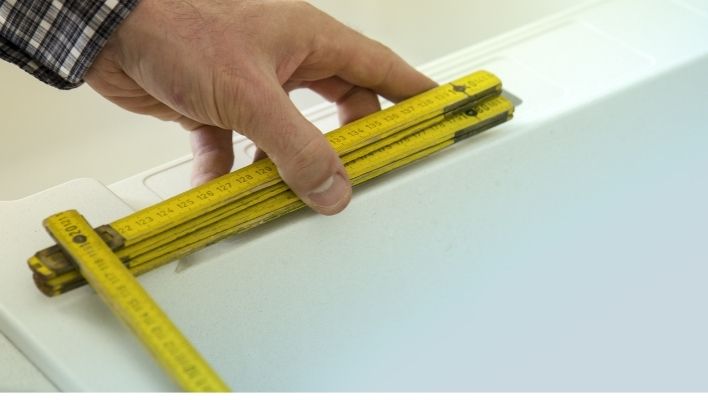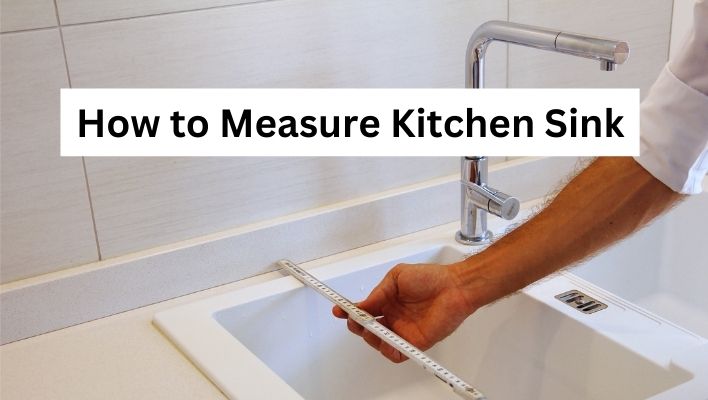To measure a kitchen sink, simply use a measuring tape to determine the length, width, and depth of the sink. Knowing the accurate measurements will help you choose the right replacement or properly fit a new sink into your kitchen countertop.
A kitchen sink is an essential component of any kitchen, used for rinsing and washing dishes, fruits, vegetables, and hands. Over time, sinks may degrade or become outdated, requiring a replacement. However, before selecting a new sink, it’s crucial to measure the existing one accurately to ensure a perfect fit.
We will guide you on how to measure your kitchen sink, providing instructions to determine the length, width, and depth. By following these steps, you will be equipped with the necessary information to select a new sink that suits your kitchen’s needs and dimensions.
Table of Contents
- Importance Of Precise Measurements
- Necessary Tools For Measuring
- Steps To Measure A Kitchen Sink
- Additional Considerations For Installing A Kitchen Sink
- Common Mistakes to Avoid When Measuring Your Kitchen Sink
- Frequently Asked Questions For How To Measure Kitchen Sink
- Conclusion
Importance Of Precise Measurements
Accurately measuring a kitchen sink is crucial for a successful installation. Precise measurements ensure proper fit and functionality, preventing any plumbing or countertop issues in the future.
Ensuring A Perfect Fit For Your Kitchen Sink
One of the most crucial aspects of installing a new kitchen sink is to ensure a perfect fit. Precise measurements play a key role in achieving this. When your kitchen sink fits perfectly, it not only enhances the overall aesthetics of your kitchen but also prevents any future issues such as leaks and water damage.
Measuring your kitchen sink accurately is essential to avoid any installation mishaps, which could be time-consuming and costly to rectify. Giving proper attention to measuring your sink before the installation process begins ensures a seamless installation, saving you from unnecessary headaches and troubles down the line.
To achieve a perfect fit for your kitchen sink, you need to take accurate measurements of the space in your kitchen cabinet where the sink will be placed. This will give you an idea of the dimensions and depth requirements for your sink.
Additionally, measuring the countertop opening where the sink will be inserted is equally important. This ensures that the sink aligns perfectly with the countertop, creating a neat finish.
Remember, even a slight miscalculation in measurements can lead to significant issues. So, it’s essential to measure and remeasure to ensure an accurate fit for your kitchen sink.
Preventing Leaks And Water Damage
Precise measurements are not just about aesthetics but also about functionality. By ensuring accurate measurements, you can prevent leaks and water damage that may occur due to ill-fitting sinks.
When a sink doesn’t fit properly, it can lead to gaps where water can seep through. These gaps can cause water leakage, gradually damaging your kitchen cabinet and even the flooring beneath it. Over time, this can lead to costly repairs and renovations.
By taking precise measurements, you can ensure a snug fit that leaves no room for water to escape. This reduces the risk of leaks and the subsequent water damage that can occur, giving you peace of mind in the long run.
Optimizing Functionality And Aesthetics
Accurate measurements for your kitchen sink not only ensure functionality but also optimize the overall aesthetics of your kitchen space.
When your sink fits perfectly within the available space, it creates a harmonious balance with the surrounding countertops and cabinetry. This enhances the visual appeal of your kitchen, making it look more polished and well-designed.
Moreover, precise measurements allow you to choose a sink that complements your kitchen layout and offers optimal functionality. You can select a sink with the right dimensions, shape, and depth to suit your daily needs, whether it’s washing large pots and pans or simply rinsing dishes.
Ultimately, by paying attention to accurate measurements, you can achieve a perfect fit for your kitchen sink, prevent leaks and water damage, and optimize both the functionality and aesthetics of your kitchen space.
Read Also: Kitchen Island Lighting Ideas 2023: Trendy Designs
Necessary Tools For Measuring

To measure a kitchen sink, you’ll need a measuring tape or ruler to determine the dimensions accurately. Additionally, you may also require a level and a pencil to mark the positioning for installation. These essential tools will help ensure a precise fit for your kitchen sink.
When it comes to measuring your kitchen sink, having the right tools on hand is essential. Accurate measurements will ensure that your new sink fits perfectly and functions as it should. To get started, gather the following tools:
Measuring Tape Or Ruler
A measuring tape or ruler is a must-have tool for any measurement task, including measuring your kitchen sink. Make sure it is long enough to reach the entire length and width of your sink. A flexible measuring tape is often the easiest to work with, as it can easily curve and bend around corners.
Level
A level is another vital tool that will help you achieve a proper installation. It ensures that your sink is perfectly level and eliminates any sloping or tilting. Using a level will result in a sink that not only looks professional but also functions optimally.
Marking Pencil Or Tape
A marking pencil or tape is handy for marking the outline of your sink on the countertop. Tracing the edges will give you a clear guide when it comes time for installation. Choose a pencil or tape that is easily visible on your countertop material.
Paper And Pen For Recording Measurements
Recording measurements is crucial to avoid any confusion or mistakes during the installation process. Keep a piece of paper and a pen handy to write down the measurements of your sink. Make sure to label each measurement correctly, noting the length and width.
With these necessary tools in hand, you are ready to measure your kitchen sink accurately. Taking the time to measure correctly will save you from future headaches and ensure a smooth installation process.
Steps To Measure A Kitchen Sink
Measuring your kitchen sink properly is essential in ensuring a proper fit and seamless installation. By following these steps, you can accurately measure your kitchen sink and make the necessary preparations for a successful installation.

Clearing The Sink Area And Removing Any Obstacles
Before taking measurements, it is important to clear the sink area of any obstructions that might hinder accurate measurements. Remove any dishes, cutting boards, or other objects from the sink and surrounding countertop area. This allows for clear access and ensures accurate measurements.
Taking Accurate Measurements Of The Sink Dimensions:
Now that the sink area is clear, it’s time to measure the actual sink dimensions. This involves measuring the length, width, and depth of the sink.
Measuring the length and width of the sink
- Start by measuring the length of the sink from one edge to the other. Place your tape measure at one edge of the sink and extend it to the opposite edge. Take note of this measurement.
- Next, measure the width of the sink by placing your tape measure from the front edge to the back edge. Take note of this measurement as well.
Determining the depth of the sink
The depth of the sink refers to how deep it is from the top to the bottom. To measure the depth, place your tape measure at the top edge of the sink and extend it to the bottom. Note down this measurement, as it will be essential for determining the compatibility with your countertop.
Assessing The Countertop Cutout Dimensions:
In addition to measuring the sink itself, it is crucial to assess the dimensions of the countertop cutout where the sink will be installed. This ensures that the sink will fit properly without any protrusions or misalignments.
Measuring the overall length and width of the countertop
- Measure the overall length of the countertop by placing your tape measure from one end to the other. Take note of this measurement.
- Similarly, measure the width of the countertop by placing your tape measure from the front to the back. Note down this measurement as well.
Determining the clearance required for the sink installation
When determining the clearance required for the sink installation, consider the manufacturer’s recommendations and any specific guidelines provided with the sink. Typically, a certain clearance is necessary to ensure the sink fits properly and allows for easy installation.
Read Also: Brown Kitchen Cabinets Ideas
Verifying The Measurements For Accuracy And Consistency
After taking all the necessary measurements, it is essential to verify their accuracy and consistency. Double-check each measurement to ensure they align with the sink and countertop dimensions. This step helps to avoid any potential issues during the installation process.
By following these steps and taking accurate measurements, you can confidently select a kitchen sink that fits perfectly in your space and enjoy a seamless installation.
Additional Considerations For Installing A Kitchen Sink
When it comes to installing a kitchen sink, there are a few additional considerations that can ensure the process goes smoothly and that you end up with a sink that not only fits your needs but also matches your kitchen’s overall aesthetic. In this section, we will discuss three key factors to consider when measuring and installing a kitchen sink.
Matching The Sink Type To The Countertop Material
One important consideration when selecting a sink for your kitchen is to ensure that it matches the countertop material. This is not only for visual appeal but also for functional purposes. Certain sink materials are better suited for specific countertop materials to avoid unnecessary damage and maintenance.
If you have a granite or quartz countertop, for example, a sink made from the same material would create a seamless integration that not only looks great but also offers durability and easy maintenance. On the other hand, if you have a laminate countertop, an under-mount stainless steel sink might be a more suitable option, as it provides a clean look and is resistant to staining.
Consulting The Manufacturer’s Guidelines For Specific Installation Requirements
Before proceeding with the installation of your kitchen sink, it’s important to consult the manufacturer’s guidelines for specific installation requirements. Each sink may have unique instructions that should be followed to ensure proper installation and avoid any complications down the line.
The manufacturer’s guidelines may include details about the type of mounting, whether it’s top-mounted or under-mounted, and any additional accessories or tools that may be required for installation. Following these guidelines will not only help you achieve a secure and long-lasting sink installation but also ensure you don’t void any warranty that may be in place.
Selecting The Right Sink Size And Style For Your Kitchen
Another crucial consideration is selecting the right sink size and style that suits your kitchen’s layout and workflow. This includes determining whether you need a single or double-bowl sink and the appropriate dimensions for your space.
If you have a smaller kitchen, you might want to consider a single-bowl sink, as it maximizes the available countertop surface. However, if you frequently handle large pots and pans, a double-bowl sink might be more practical, allowing you to multitask efficiently.
Hiring A Professional Installer If Needed
In some cases, it may be necessary to hire a professional installer for your kitchen sink installation. This is especially true if you’re unfamiliar with plumbing or have complex requirements that require expertise.
A professional installer will have the necessary skills and experience to handle the installation process efficiently and minimize the risk of any issues arising. They will also be familiar with local building codes and regulations, ensuring that your sink installation adheres to the required standards.
Common Mistakes to Avoid When Measuring Your Kitchen Sink

Accurate measurement is crucial when it comes to installing a kitchen sink. Failing to measure correctly can lead to issues such as a sink that doesn’t fit properly or a mismatched configuration. To help you avoid these common mistakes, we’ll discuss key factors to consider when measuring your kitchen sink.
Failing To Account For Clearance Space During Measurement
One common mistake to avoid is failing to account for clearance space when measuring your kitchen sink. You need to ensure that there’s adequate space around the sink to accommodate faucets, soap dispensers, and other accessories. Neglecting this can result in cramped working conditions and difficulty installing essential fixtures.
Using Inaccurate Tools Or Measurements
Another mistake to steer clear of is the use of inaccurate tools or measurements during the process. Utilizing an unreliable tape measure or imprecise ruler can lead to incorrect dimensions. Make sure to use a high-quality tape measure and double-check your measurements to ensure accuracy. Remember, precision is key when it comes to a well-fitting kitchen sink.
Neglecting To Consider Sink Configuration (Single Or Double Bowl)
Consideration of the sink configuration is crucial when measuring a new kitchen sink. Whether you’re looking to install a single or double bowl sink, not taking this into account can cause significant issues down the line. Each configuration requires different measurements, including the overall length, width, and depth. By overlooking this detail, you risk purchasing the wrong size sink, resulting in wasted time and unnecessary expenses.
Overlooking Countertop Material Compatibility
Lastly, it’s important not to overlook countertop material compatibility when measuring your kitchen sink. Different materials, such as granite, quartz, or laminate, have varying thicknesses. This variation impacts the measurements needed for installation. Taking into account the specific countertop material will ensure a seamless fit and prevent any future complications.
Frequently Asked Questions For How To Measure Kitchen Sink
How Do You Measure A Kitchen Sink?
To measure a kitchen sink, use a measuring tape to measure the width, depth, and height of the sink. For the width, measure from one edge to the opposite edge. For the depth, measure from the front of the sink to the back.
For the height, measure from the bottom of the sink to the top.
What Is The Standard Size Of A Kitchen Sink?
The standard size of a kitchen sink can vary, but the most common sizes are 22 inches for single-bowl sinks and 33 inches for double-bowl sinks. The depth of the sink is typically around 9 to 10 inches. It’s important to measure your space and choose a sink size that fits well in your kitchen.
How Do I Choose The Right Size Kitchen Sink?
When choosing the right size kitchen sink, consider the size of your kitchen, your countertop space, and the amount of dishes you typically handle. Measure the available space in your kitchen and select a sink that fits well within that space.
Additionally, consider the number of bowls you need and the depth of the sink to accommodate your needs.
Conclusion
To summarize, accurate measurement of a kitchen sink is essential for a successful installation. By following the step-by-step guide provided in this blog post, you can ensure that you measure your sink correctly and avoid any future complications. Remember to take accurate measurements of the width, depth, and height, and consider any additional features such as faucet holes.
Proper measurement guarantees a seamless fit and a functional kitchen space. Happy measuring!



